Athanasios Mouchtaris
Alexa Machine Learning, Amazon, USA
Saten: Sparse Augmented Tensor Networks for Post-Training Compression of Large Language Models
May 20, 2025Abstract:The efficient implementation of large language models (LLMs) is crucial for deployment on resource-constrained devices. Low-rank tensor compression techniques, such as tensor-train (TT) networks, have been widely studied for over-parameterized neural networks. However, their applications to compress pre-trained large language models (LLMs) for downstream tasks (post-training) remains challenging due to the high-rank nature of pre-trained LLMs and the lack of access to pretraining data. In this study, we investigate low-rank tensorized LLMs during fine-tuning and propose sparse augmented tensor networks (Saten) to enhance their performance. The proposed Saten framework enables full model compression. Experimental results demonstrate that Saten enhances both accuracy and compression efficiency in tensorized language models, achieving state-of-the-art performance.
Wanda++: Pruning Large Language Models via Regional Gradients
Mar 06, 2025Abstract:Large Language Models (LLMs) pruning seeks to remove unimportant weights for inference speedup with minimal performance impact. However, existing methods often suffer from performance loss without full-model sparsity-aware fine-tuning. This paper presents Wanda++, a novel pruning framework that outperforms the state-of-the-art methods by utilizing decoder-block-level \textbf{regional} gradients. Specifically, Wanda++ improves the pruning score with regional gradients for the first time and proposes an efficient regional optimization method to minimize pruning-induced output discrepancies between the dense and sparse decoder output. Notably, Wanda++ improves perplexity by up to 32\% over Wanda in the language modeling task and generalizes effectively to downstream tasks. Further experiments indicate our proposed method is orthogonal to sparsity-aware fine-tuning, where Wanda++ can be combined with LoRA fine-tuning to achieve a similar perplexity improvement as the Wanda method. The proposed method is lightweight, pruning a 7B LLaMA model in under 10 minutes on a single NVIDIA H100 GPU.
MaZO: Masked Zeroth-Order Optimization for Multi-Task Fine-Tuning of Large Language Models
Feb 17, 2025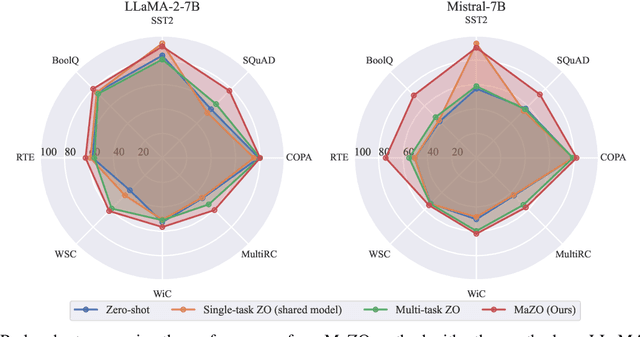
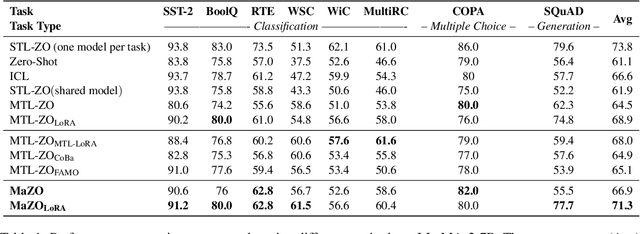


Abstract:Large language models have demonstrated exceptional capabilities across diverse tasks, but their fine-tuning demands significant memory, posing challenges for resource-constrained environments. Zeroth-order (ZO) optimization provides a memory-efficient alternative by eliminating the need for backpropagation. However, ZO optimization suffers from high gradient variance, and prior research has largely focused on single-task learning, leaving its application to multi-task learning unexplored. Multi-task learning is crucial for leveraging shared knowledge across tasks to improve generalization, yet it introduces unique challenges under ZO settings, such as amplified gradient variance and collinearity. In this paper, we present MaZO, the first framework specifically designed for multi-task LLM fine-tuning under ZO optimization. MaZO tackles these challenges at the parameter level through two key innovations: a weight importance metric to identify critical parameters and a multi-task weight update mask to selectively update these parameters, reducing the dimensionality of the parameter space and mitigating task conflicts. Experiments demonstrate that MaZO achieves state-of-the-art performance, surpassing even multi-task learning methods designed for first-order optimization.
QuZO: Quantized Zeroth-Order Fine-Tuning for Large Language Models
Feb 17, 2025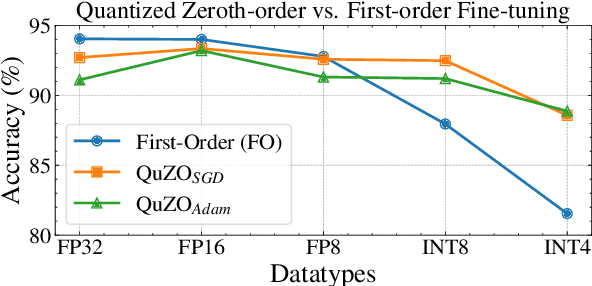
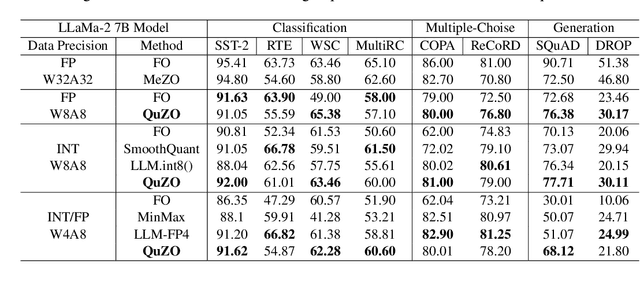


Abstract:Language Models (LLMs) are often quantized to lower precision to reduce the memory cost and latency in inference. However, quantization often degrades model performance, thus fine-tuning is required for various down-stream tasks. Traditional fine-tuning methods such as stochastic gradient descent and Adam optimization require backpropagation, which are error-prone in the low-precision settings. To overcome these limitations, we propose the Quantized Zeroth-Order (QuZO) framework, specifically designed for fine-tuning LLMs through low-precision (e.g., 4- or 8-bit) forward passes. Our method can avoid the error-prone low-precision straight-through estimator, and utilizes optimized stochastic rounding to mitigate the increased bias. QuZO simplifies the training process, while achieving results comparable to first-order methods in ${\rm FP}8$ and superior accuracy in ${\rm INT}8$ and ${\rm INT}4$ training. Experiments demonstrate that low-bit training QuZO achieves performance comparable to MeZO optimization on GLUE, Multi-Choice, and Generation tasks, while reducing memory cost by $2.94 \times$ in LLaMA2-7B fine-tuning compared to quantized first-order methods.
AdaZeta: Adaptive Zeroth-Order Tensor-Train Adaption for Memory-Efficient Large Language Models Fine-Tuning
Jun 26, 2024



Abstract:Fine-tuning large language models (LLMs) has achieved remarkable performance across various natural language processing tasks, yet it demands more and more memory as model sizes keep growing. To address this issue, the recently proposed Memory-efficient Zeroth-order (MeZO) methods attempt to fine-tune LLMs using only forward passes, thereby avoiding the need for a backpropagation graph. However, significant performance drops and a high risk of divergence have limited their widespread adoption. In this paper, we propose the Adaptive Zeroth-order Tensor-Train Adaption (AdaZeta) framework, specifically designed to improve the performance and convergence of the ZO methods. To enhance dimension-dependent ZO estimation accuracy, we introduce a fast-forward, low-parameter tensorized adapter. To tackle the frequently observed divergence issue in large-scale ZO fine-tuning tasks, we propose an adaptive query number schedule that guarantees convergence. Detailed theoretical analysis and extensive experimental results on Roberta-Large and Llama-2-7B models substantiate the efficacy of our AdaZeta framework in terms of accuracy, memory efficiency, and convergence speed.
Accelerator-Aware Training for Transducer-Based Speech Recognition
May 12, 2023



Abstract:Machine learning model weights and activations are represented in full-precision during training. This leads to performance degradation in runtime when deployed on neural network accelerator (NNA) chips, which leverage highly parallelized fixed-point arithmetic to improve runtime memory and latency. In this work, we replicate the NNA operators during the training phase, accounting for the degradation due to low-precision inference on the NNA in back-propagation. Our proposed method efficiently emulates NNA operations, thus foregoing the need to transfer quantization error-prone data to the Central Processing Unit (CPU), ultimately reducing the user perceived latency (UPL). We apply our approach to Recurrent Neural Network-Transducer (RNN-T), an attractive architecture for on-device streaming speech recognition tasks. We train and evaluate models on 270K hours of English data and show a 5-7% improvement in engine latency while saving up to 10% relative degradation in WER.
* Accepted to SLT 2022
Lookahead When It Matters: Adaptive Non-causal Transformers for Streaming Neural Transducers
May 09, 2023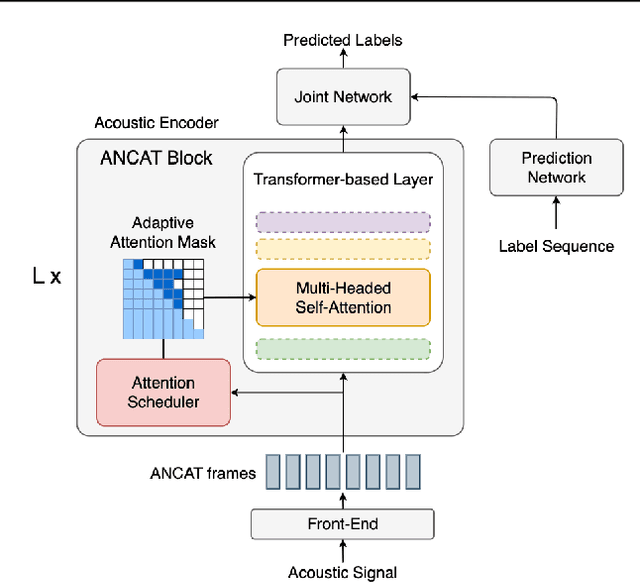
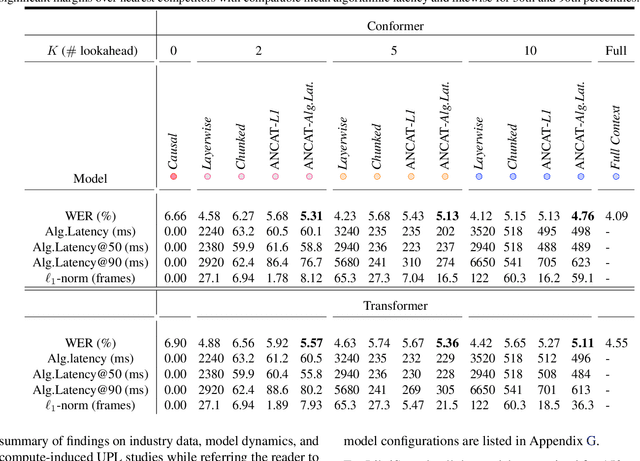
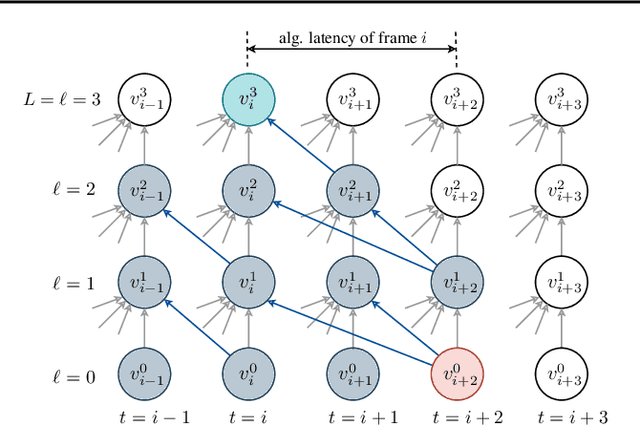
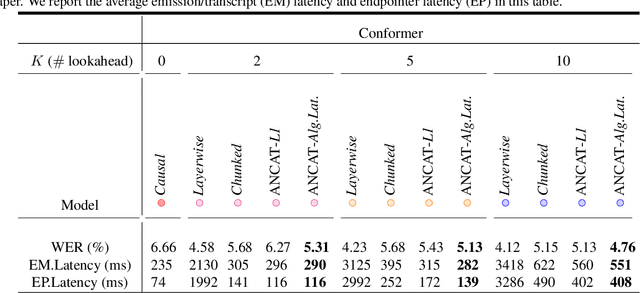
Abstract:Streaming speech recognition architectures are employed for low-latency, real-time applications. Such architectures are often characterized by their causality. Causal architectures emit tokens at each frame, relying only on current and past signal, while non-causal models are exposed to a window of future frames at each step to increase predictive accuracy. This dichotomy amounts to a trade-off for real-time Automatic Speech Recognition (ASR) system design: profit from the low-latency benefit of strictly-causal architectures while accepting predictive performance limitations, or realize the modeling benefits of future-context models accompanied by their higher latency penalty. In this work, we relax the constraints of this choice and present the Adaptive Non-Causal Attention Transducer (ANCAT). Our architecture is non-causal in the traditional sense, but executes in a low-latency, streaming manner by dynamically choosing when to rely on future context and to what degree within the audio stream. The resulting mechanism, when coupled with our novel regularization algorithms, delivers comparable accuracy to non-causal configurations while improving significantly upon latency, closing the gap with their causal counterparts. We showcase our design experimentally by reporting comparative ASR task results with measures of accuracy and latency on both publicly accessible and production-scale, voice-assistant datasets.
Robust Acoustic and Semantic Contextual Biasing in Neural Transducers for Speech Recognition
May 09, 2023Abstract:Attention-based contextual biasing approaches have shown significant improvements in the recognition of generic and/or personal rare-words in End-to-End Automatic Speech Recognition (E2E ASR) systems like neural transducers. These approaches employ cross-attention to bias the model towards specific contextual entities injected as bias-phrases to the model. Prior approaches typically relied on subword encoders for encoding the bias phrases. However, subword tokenizations are coarse and fail to capture granular pronunciation information which is crucial for biasing based on acoustic similarity. In this work, we propose to use lightweight character representations to encode fine-grained pronunciation features to improve contextual biasing guided by acoustic similarity between the audio and the contextual entities (termed acoustic biasing). We further integrate pretrained neural language model (NLM) based encoders to encode the utterance's semantic context along with contextual entities to perform biasing informed by the utterance's semantic context (termed semantic biasing). Experiments using a Conformer Transducer model on the Librispeech dataset show a 4.62% - 9.26% relative WER improvement on different biasing list sizes over the baseline contextual model when incorporating our proposed acoustic and semantic biasing approach. On a large-scale in-house dataset, we observe 7.91% relative WER improvement compared to our baseline model. On tail utterances, the improvements are even more pronounced with 36.80% and 23.40% relative WER improvements on Librispeech rare words and an in-house testset respectively.
Dual-Attention Neural Transducers for Efficient Wake Word Spotting in Speech Recognition
Apr 05, 2023



Abstract:We present dual-attention neural biasing, an architecture designed to boost Wake Words (WW) recognition and improve inference time latency on speech recognition tasks. This architecture enables a dynamic switch for its runtime compute paths by exploiting WW spotting to select which branch of its attention networks to execute for an input audio frame. With this approach, we effectively improve WW spotting accuracy while saving runtime compute cost as defined by floating point operations (FLOPs). Using an in-house de-identified dataset, we demonstrate that the proposed dual-attention network can reduce the compute cost by $90\%$ for WW audio frames, with only $1\%$ increase in the number of parameters. This architecture improves WW F1 score by $16\%$ relative and improves generic rare word error rate by $3\%$ relative compared to the baselines.
Leveraging Redundancy in Multiple Audio Signals for Far-Field Speech Recognition
Mar 01, 2023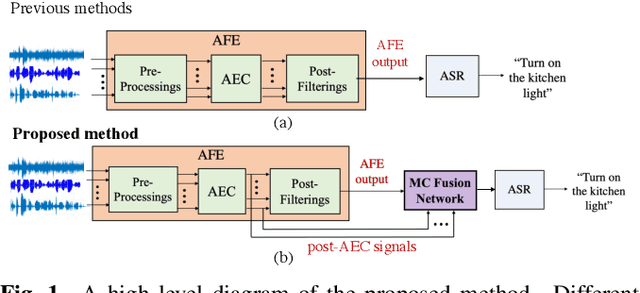


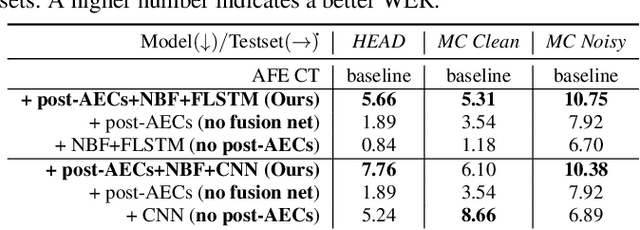
Abstract:To achieve robust far-field automatic speech recognition (ASR), existing techniques typically employ an acoustic front end (AFE) cascaded with a neural transducer (NT) ASR model. The AFE output, however, could be unreliable, as the beamforming output in AFE is steered to a wrong direction. A promising way to address this issue is to exploit the microphone signals before the beamforming stage and after the acoustic echo cancellation (post-AEC) in AFE. We argue that both, post-AEC and AFE outputs, are complementary and it is possible to leverage the redundancy between these signals to compensate for potential AFE processing errors. We present two fusion networks to explore this redundancy and aggregate these multi-channel (MC) signals: (1) Frequency-LSTM based, and (2) Convolutional Neural Network based fusion networks. We augment the MC fusion networks to a conformer transducer model and train it in an end-to-end fashion. Our experimental results on commercial virtual assistant tasks demonstrate that using the AFE output and two post-AEC signals with fusion networks offers up to 25.9% word error rate (WER) relative improvement over the model using the AFE output only, at the cost of <= 2% parameter increase.
 Add to Chrome
Add to Chrome Add to Firefox
Add to Firefox Add to Edge
Add to Edge